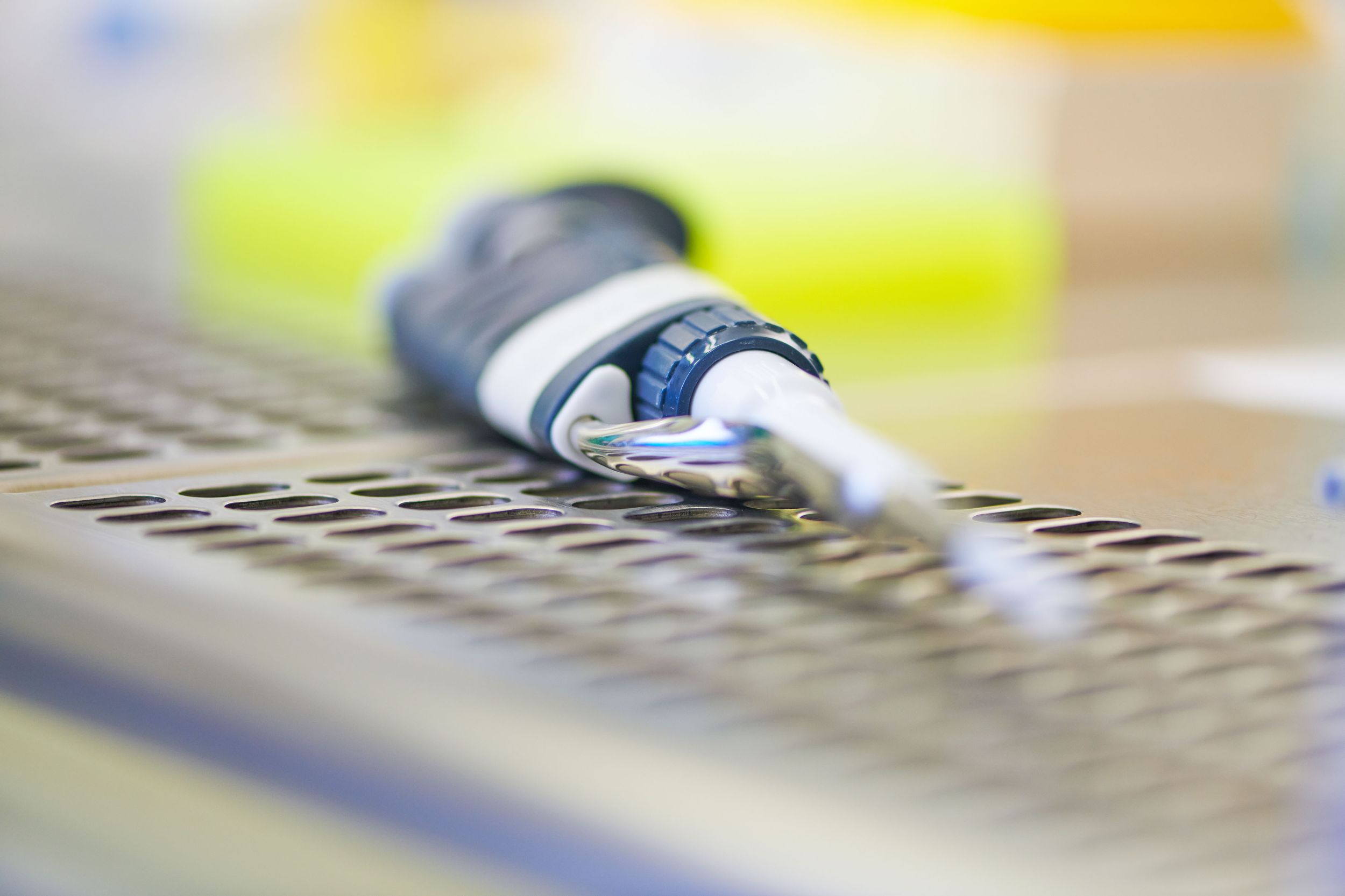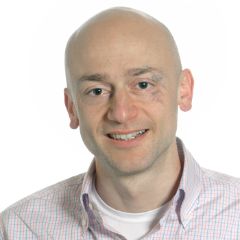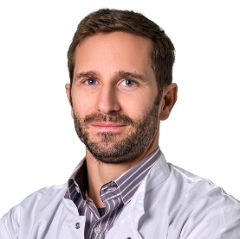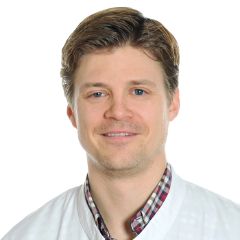
Research
Orthopaedics and Traumatology Research
The Clinic for Orthopaedics and Traumatology has a national and international presence in orthopaedic research that is based on a broad representation of the various subspecialties within this surgical field. Our faculty members are dedicated to development of novel surgical modalities and therapeutic concepts by conducting translational medicine that bridges basic science and clinical practice. We aim to create a rich research environment by promoting active, multidisciplinary cooperation among orthopaedic surgeons, radiologists, engineers, movement scientists, study nurses, biostatisticians and physiotherapists and collaborations with other centers. Fundamental to our research endeavor is providing a stimulating educational environment for students, orthopaedic registrars and researchers. Research at our clinic is organized in the focus areas tissue engineering, clinical research and functional biomechanics.
Cartilage regeneration
Current study Nose to Knee II
In a unique innovative study, the Orthopaedics/Traumatology Department of the University Hospital Basel is investigating the clinical efficacy of cartilage grafts cultivated from autologous nasal cartilage cells for the repair of cartilage defects in the knee joint. The study is being conducted in close collaboration with Prof. Ivan Martin, head of the Tissue Engineering Laboratory, which focuses on the cultivation of cartilage and bone tissue from the body's own cells. This close collaboration between physicians and researchers enables the University Hospital Basel to offer patients new, innovative therapies, making it one of the leading centers in Europe in the field of cartilage regeneration.
Innovation of the study
Cartilage injuries in the joint can lead to pain and restricted movement and are known to double the likelihood of suffering from degenerative joint diseases such as osteoarthritis in old age. However, cartilage tissue heals poorly on its own as it is not supplied with blood, so treatment is necessary.
Cartilage repair treatments have the potential not only to relieve pain and improve quality of life for younger patients, but also to delay or eliminate the need for joint replacement in older patients.
However, current treatment methods often do not lead to satisfactory results, especially in older patients or with more complex injuries. In this unique clinical trial, we aim to introduce two innovations:
- The use of autologous nasal cartilage cells: It has already been shown that these have better and more reproducible properties than the commonly used articular cartilage cells in terms of growth and the ability to form cartilage. In addition, these properties are less dependent on the age of the patient.
- The implantation of a mature tissue (with cartilage-specific proteins) instead of an immature tissue (little to no cartilage-specific proteins).
What do we want to research?
Having already demonstrated the safety and feasibility of this method in an initial study, the aim of this study is to compare the clinical efficacy of a mature tissue (N-TEC) with that of an immature tissue (N-CAM) for the treatment of isolated cartilage defects in the knee. Patients are randomly divided into two groups, one receiving the mature tissue and the other the immature tissue. Medical checks are then carried out after 6 weeks, 3, 12 and 24 months, some of which also include an MRI (3, 12 and 24 months) and/or questionnaires for self-assessment of health status (12 and 24 months). The questions to be answered by this study are
- Can a pre-matured tissue increase clinical efficacy (patient self-assessment questionnaire)?
- Does a pre-matured tissue integrate just as well into the surrounding tissue?
- Is the quality of the repair tissue better than with conventional techniques?
- Is there a preferred treatment (mature or immature tissue) in terms of symptom onset (acute versus chronic cartilage defects)?
Answering these questions requires the inclusion of a total of 108 patients in a multicenter, prospective study with 5 centers. We are recruiting patients between 18 and 65 years of age who have one or two symptomatic cartilage defects with a total size between 2 and 8 cm2 (as assessed by MRI). Degenerative diseases such as osteoarthritis, meniscus replacement or operations on the diseased knee within the last 12 months are exclusion criteria.
If you are interested in the study, please contact: Marcus.Mumme@usb.ch
Further information
Description and details of the clinical trial:
Team

Prof. Dr. Ivan Martin
Forschungsgruppenleiter
DBM Tissue Engineering

PD Dr. Marcus Mumme
Kaderarzt / Standort Bethesda
Orthopädie und Traumatologie

PD Dr. Christian Egloff
Leitender Arzt
Orthopädie und Traumatologie Ärzte
Leiter Team Knieorthopädie
Tissue engineering
The ultimate goal of the Tissue Engineering Group is to generate cellular grafts to repair cartilage and bone tissues, as well as complex osteochondral lesions. Beyond a potential clinical use as implants, the engineered constructs also represent invaluable 3D model systems to study progenitor cell differentiation and tissue development. The main scientific questions are related to
(i) the functionality of human mesenchymal cells (mature, progenitor, stem cells) for bone and cartilage repair,
(ii) the effect of specific chemical and physical environmental factors on skeletal tissue engineering, and
(iii) the interaction of different cell types during ex vivo tissue morphogenesis. The projects, at the interface between fundamental research and clinical translation, bring together the competences of biologists, engineers and surgeons.
Beyond national (SNSF) and industrial programs, research is funded in the context of European consortia, which favor a strong international networking of the group.
Clinical Research
The Clinical Research Group initiates and supports clinical studies and clinical trials within the Clinic for Orthopaedics and Traumatology. A multidisciplinary team of surgeons, biostatisticians, study nurses and regulatory affairs managers ensure highest scientific standards to establish and contribute to national and international databases and registries. Clinical research is prerequisite for the critical evaluation of current practice and base for innovation. We encourage formal literature reviews and retrospective studies as preparation for prospective evaluations and clinical trials, and clinicians from all orthopedic and traumatologic subspecialties contribute to the generating knowledge in several areas of expertise embedded in daily practice.
Current clinical research topics
- Orthogeriatrics including treatment of fragility fractures and development of treatment pathways
- Research on health care provision and quality
- Bone infection, reconstruction and translational tissue engineering
- Cartilage research and translational tissue engineering
- Upper Extremity Trauma: evaluation of treatment pathways (e.g. proximal humeral fracture of the elderly) and mid- and long-term results
- Upper Extremity Trauma: evaluation of image based and score based decision criteria for different treatment options (e.g. proximal humeral fracture, distal radial fracture)
- Outcome and complications after arthroscopic rotator cuff repair and total shoulder arthroplasty
Functional Biomechanics Research Group
The Functional Biomechanics Group focuses on understanding the complexity of the human body and its function. In our body, nerves, muscles and the skeletal system work together and form the functional chain of biomechanics. Human function depends on the necessary and desired activity such as daily activities or athletic activities. In our laboratory, we study these interrelationships and research questions on the initiation, progression and treatment of orthopaedic diseases (e.g. osteoarthritis) and traumotological events (e.g. fractures). Scientists and clinicians work hand in hand to facilitate clinically relevant answers of important questions and to fulfill our treatment goal of preserving or restoring optimal function in osteoarthritis, after injury or after joint replacement. Our research is funded by the SNSF and local foundations.
Contact
Contact Us
We are part of the Clinic for Orthopaedics and Traumatology at the University Hospital Basel, Switzerland. Our laboratory is located in the basement of Bettenhaus 3.
Mailing address
Functional Biomechanics Laboratory
University Hospital Basel
Spitalstrasse 21
4031 Basel
Switzerland
Laboratory address
Functional Biomechanics Laboratory
University Hospital Basel
1st floor, ward block 3
Schanzenstrasse 55
4056 Basel
Switzerland
Tel. +41 61 265 9444
biomechanik@usb.ch
Team
Team Functional Biomechanics
Projects
We strive to solve clinically motivated questions on diseases and conditions of the musculoskeletal system and to translate results of laboratory studies into the clinic.
Our research topics are
- In vivo mechanosensitivity of musculoskeletal tissue
- Diagnostics, prevention and therapy of disease related gait and movement patterns
- Innovation and product development
For our current projects, we recruit
- participants with osteoarthritis at the knee or hip
- participants who have received a total knee or hip replacement
- participants with lumbar spinal stenosis
- participants with rotator cuff tear
- participants who have injured their anterior cruciate ligament 2 to 10 years ago
- healthy persons
Please contact Prof. Dr. Annegret Mündermann for details on current projects.
In vivo mechanosensitivity of musculoskeletal tissue
The core of biomechanics is the influence of forces on biological organisms. The importance of the tight interplay between mechanical and biological factors in health and disease receives increasing scientific scrutiny. In a series of laboratory studies, we study the in vivo mechanosensitivity of involved tissues in humans with the ultimate goal of designing interventions-mechanical or pharmaceutical-that prevent or delay the onset of osteoarthritis or slow down its rate of progression. Furthermore, we have developed a framework involving a walking stress test to assess the dose-response relationship between ambulatory load magnitude and the load-induced biological response of articular cartilage that maybe useful in the context of effectiveness of mechanical or pharmaceutical internvetions. These projects are currently funded through the Swiss National Science Foundation and Industry grants.
Diagnostics, prevention and therapy of disease related gait and movement patterns
The important task in collaboration with the therapy services in the coming years is to establish the diagnostics based on movement analysis. Understanding biomechanical factors as risk factors or osteoarthritis is a critical component in prevention and therapy. We combine novel portable inertial sensor systems with gold-standard camera based motion analysis to identify factors relevant for injury and disease mechanisms and treatment. More recently, we have initiated research on the effects of manual therapy on ambulatory mechanics.
Innovation and product development
In recent years, members of the Clinic for Orthopaedics and Traumatology have initiated several technical innovations and products. These included novel endoprostheses aimed at improving joint function and improved crutch cuff designs to reduce symptoms and complaints associated with crutch walking. Currently, we work on establishing protocols for IMU gait analysis and for measuring shoulder translation in clinical practice.
Current Projects
- Dose-response relationship of in vivo ambulatory load and mechanosensitive cartilage biomarkers: the role of age and tissue health (Mündermann, Egloff, Vach, Herger, Liphardt, Eckstein, Bieri, Hirschmann) (SNF)
- The effect of corrective osteotomy on in vivo cartilage mechanobiology in patients with knee osteoarthritis: cross-sectional observational single-center study (Mündermann, Egloff, Nüesch, Pagenstert, Vach, Liphardt) (SNF)
- Influence of additional weight carrying on load-induced changes in glenohumeral translation in patients with rotator cuff tear - a translational approach (Mündermann, Müller, Baumgartner, Audige, Nüesch, Bieri, Hirschmann) (SNF)
- Gait asymmetry in orthopaedic conditions of the lower extremity assessed using portable and laboratory based systems: cross-sectional observational single-center pilot study (Mündermann, Nüesch, Netzer, Egloff, Ismailidis, Pagenstert, Horisberger, Perrot, Kaufmann, Hegglin) (Merian Iselin Foundation, Swiss Orthopaedics)
- Muscle function and dynamic and postural stability in patients receiving hip or knee arthroplasty (Ismailidis, Mündermann, Pagenstert, Egloff, Vach, Kvarda, Ilchmann, Eckardt, Clauss, Ilchmann) (Swiss Orthoapedics, Deutsche Arthrose-Hilfe e.V.)
- Clinical and functional outcomes 2 years after primary ACL repair (internal bracing) (Müller, Egloff, Bühl, Nüesch, Pagenstert, Mündermann) (Deutsche Arthrose-Hilfe e.V.)
- Comparison of dynamic and static medial patellofemoral ligament operation technique for recurrent patellar dislocation (Egloff, Bartsch, Rieger (Altius), Nüesch, Mündermann)
- Muscle function and pelvic stability while walking in patients with symptomatic lumbar spinal stenosis (Netzer, Mündermann, Schären, Janßen, Nüesch, Rehani, Przybilla)
- Assessing the course of degenerative cervical spinal stenosis using functional outcomes (Schären, Netzer, Mündermann, Mandelli, Hardmeier, Schläger, Wendebourg, Nüesch, Tovo, Suter)
- Open versus closed wedge distal femoral varus osteotomy for the valgus knee. Indications, clinical and radiological outcome (Ismailidis, Egloff, Mündermann, Greppi)
- Clinical and functional outcome after lateral trochlear lengthening osteotomy (Ismailidis, Egloff, Pagenstert, Manser, Mündermann)
- Gait analysis during level and uphill walking after lengthening osteotomy of the lateral column (Nüesch, Leumann, Horisberger, Schmid, Krenn, Byrnes, Mündermann) (Merian Iselin Foundation, Swiss Society for Sports Medicine)
- Surgical versus conservative treatment of Weber B1 fracture: functional outcome using gait analysis (Nüesch, Horisberger, Saxer, Byrnes, Bürgin, Iten, Mündermann)
- Clinical outcome and electromyographic activity of the biceps after distal reinsertion using 2 suture anchors in single incision technique (Taha, Müller, Audige, Nüesch, Schneider)
Funding Sources
-
Swiss National Science Foundation; University Hospital Basel; Merian Iselin Foundation; Swiss Orthopaedics; Deutsche Arthrosehilfe; Meda Pharma AG
Recent publications
Publications on Pubmed
Please find a complete list of our publications on Pubmed.
Research teams
In the Functional Biomechanics Laboratory, we research the development and course of treatment of orthopaedic diseases (e.g. osteoarthritis) and traumatological events (e.g. bone fractures). Scientists and doctors work very closely together to answer key questions, such as how we can maintain or restore optimal function in osteoarthritis, after an injury or after a joint replacement. We use the latest biomechanical methods to investigate various issues:
- How can joint function in osteoarthritis be improved to delay progression of the disease?
- What role does muscle strength play in function after an injury?
- Which treatment method ensures the best function after a joint injury?
- To what extent is human function affected by joint replacement and how can treatment be improved?
- How does joint loading during everyday activities affect the metabolism of articular cartilage?
How we work
To answer these important questions, we carry out muscle function tests and gait analyses as well as blood tests. Our clinical research involves patients and healthy individuals as research subjects, who are informed about current studies by the respective investigator. Interested persons can also contact our research team directly. Information on current and completed research projects can be found on our website.
We are currently recruiting the following research teams:
- Persons with planned knee TEP or
- Persons with planned hip TEP or
- Persons 2 to 10 years after cruciate ligament injury
- healthy persons.
If one of these groups applies to you and you are interested in participating in a study, please contact us at biomechanik@usb.ch
